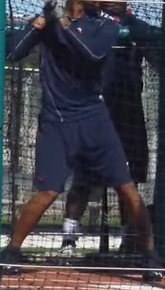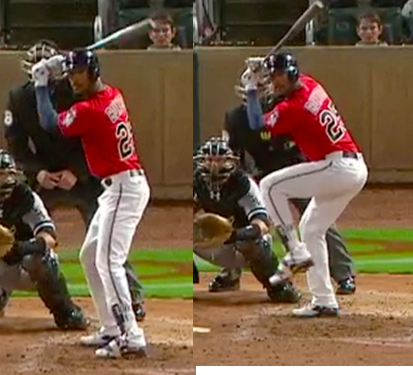Why Can’t Byron Buxton Hit?

Byron Buxton is in a SLUMP. As of today, he is 4 for 47, and has struck out in over half of his at-bats. He seems like he can hit every other year. He is only 23, and if he weren’t such a highly touted prospect, most people would probably not bat an eyelash at the fact that he is struggling with big league pitching. Luckily, because he has been such a monster prospect, there is a lot of available video of his swing. I dedicated most of my analysis to his swing throughout 2016 season with the limited video available from this year and then compared them to his swing in 2015 (the last year he hit well) and his swing during high school.
The first thing that really stuck out to me when watching him take batting practice is that the entire right side of his body seems awkward– his right pelvis is depressed, his knee is super far under his pelvis, and his spine has a sideways curve. More than that, when we look head-on it is possible to see that Buxton begins his stance with an anterior pelvic tilt, which seems to disappear as he loads his swing. There is a lot going on biomechanically that is not optimal. I am a firm believer that alignment plays the biggest role in how effective and repeatable any athletic movement will be. Considering the precision required in hitting a baseball, I think it is often overlooked.
Buxton puts his body in a very difficult position to get full, effective, efficient neuromuscular recruitment. His rear pelvis is almost completely depressed as he begins his swing, cutting off access to what should be the main driver of his swing. There isn’t a lot of motion in this joint, so it is subtle. The video below of Jose Bautista shows it extremely well (even though it looks like he was fooled by an off-speed pitch). We can see that as soon as his front foot lands there is a downward and rotary motion starting at the pelvis. This never happens with Byron because he has no room left to do it. If he hadn’t put his body already at the end range of this motion, I posit that he would have difficulty properly initiating it due to his anterior pelvic tilt. Basically, the muscles surrounding his anterior pelvis are likely either too short or too long. Both of which decrease a muscle’s ability to forcefully contract.
As mentioned in previous articles, this lack of proximal stability decreases distal mobility, so I will not beat a dead horse (or a live one), by going into more detail on this topic here. We can see that Buxton does not engage his core to the same extent that Bautista does when looking at the point when their pelvises stop moving. Look at the elongation that Bautista has through his right side compared to Buxton’s shortening. I liken this to a primitive equilibrium reaction. Before an infant has developed their core musculature, if they are thrown off balance to the side, they will shorten on the side to which they are pushed to bring their center of mass closer to the ground so it will be easier to regain their balance. As the core develops, they will eventually elongate to that same side in order to remain upright. Bautista is the child on the left; Buxton the right.
In short, Byron Buxton’s swing is so broken, beginning with his stance into his initiation, that I don’t think it is even worth analyzing the rest of it. I don’t know if he has a lack of mobility that is causing this (doubtful because he is so athletic in other regards), but he definitely has some motor control issues when it comes to engaging his core. I would venture to guess that he is aiming to recreate the feeling he has when he is on a hot streak. However, that is difficult to achieve when the stable base (core) isn’t consistently in the same position, as trying to create the same sensation of movement is going to lead to different and inconsistent results.
-Mike Plude



















